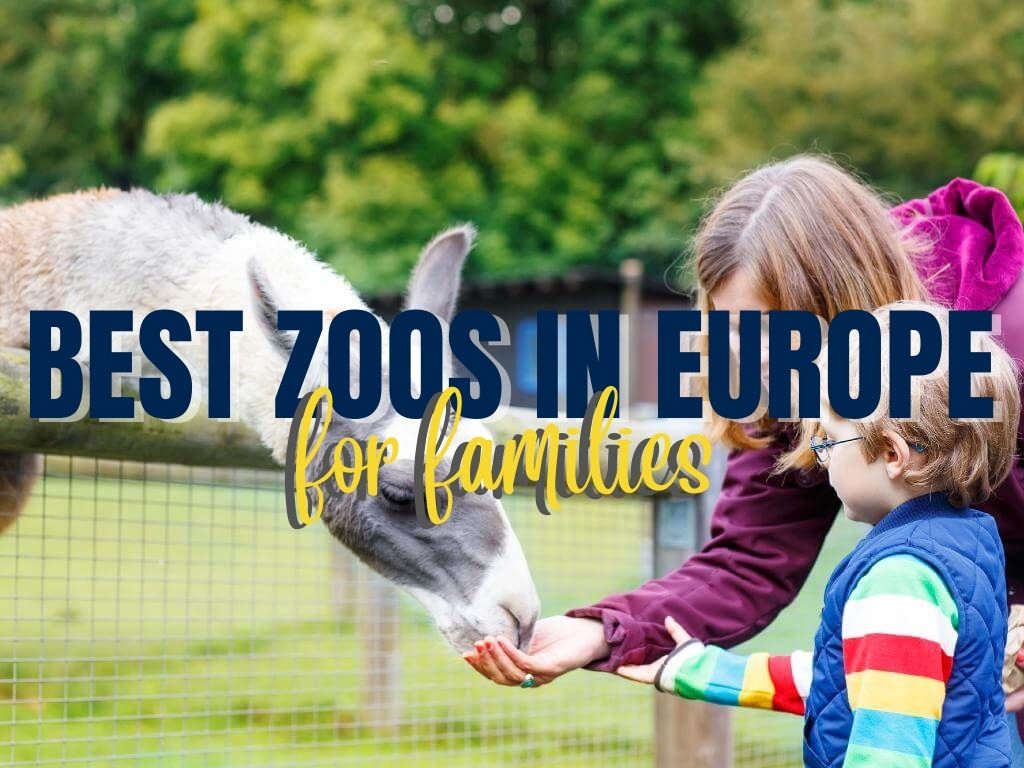15 Best Zoos in Europe for Families (+ 2 Safari Parks!)
We always wanted to travel around the world to meet new people, get to know cultures, and see beautiful sights. Now that we are traveling to other countries like Cuba and Colombia with kids, we want this experience to be an educational adventure too! As much as we enjoy seeing animals in their natural habitat, our kids love an occasional zoo visit as well – and their excitement, whenever they see animals up close, makes us happy as well. Along with other families, here are our experiences and recommendations for the best zoos in Europe.
There’s a good chance this post contains affiliate links. This means that if you purchase anything through one of our links, we’ll receive a small fee (it won’t cost you anything, promise!). As an Amazon Affiliate, we earn from qualifying purchases. If you would like to learn more about our affiliate partners, click here for our disclaimer.
The Best Zoos in Europe to Visit with the Family
#1 Colchester Zoo, UK

Colchester Zoo in Essex, UK is a great zoo in Europe. It’s home to over 180 species. The zoo is divided into 36 different areas. One of the most impressive exhibits is ‘Kingdom of the Wild’. This large outdoor paddock has giraffes, ostriches, rhinos, zebras, and great kudu’s all living together, similar to how they would in the African savanna. There are also additional elephant and giraffe feeding experiences for an additional cost which goes towards the zoo’s operational fund. These are limited and act as part of the animal’s enrichment and regular diet.
Chimpanzee Lookout and Rajang’s Forest are two other awesome exhibits that have recently been renovated.
The Colchester Zoo is ethical, meeting the standards of the Zoo Licensing Act. It is also part of EAZA (European Associations of Zoos and Aquaria) which focuses on education, conservation, and research.
It’s part of multiple breeding programmes and has its charity ‘Action For The Wild’ which supports conservation projects worldwide, including the UmPhafa Reserve in South Africa.
An average visit can take between 4 to 6 hours to see everything at a leisurely pace. There’s a large parking area, playgrounds, gift shop, restaurants, and food kiosks.
Contributed by Kylie from Essex Explored
Get tickets to Colchester Zoo for only €31.36! The zoo is open from 09:30 – 17:30. If you want to go inside the zoo again on the same day, get the wristband at the exit.
#2 Salzburg Zoo, Austria
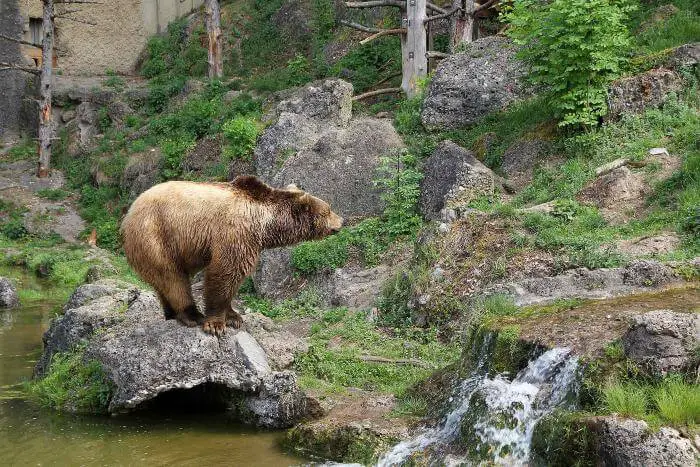
One of the best zoos in the world is located in the Austrian city of Salzburg: Salzburg Zoo Hellbrunn.
This zoo can look back on a long history, because already in the 15th century this was a game park of the prince archbishops.
The complex with the castle, the fountains, and the zoo was then completed in 1619.
During a visit, you will discover about 1,500 animals and 150 species of animals from different continents.
Beautiful and a real highlight is the Africa part, a savannah-like complex with a lion house.
In Eurasia, you will be amazed by alpine ibexes and brown bears, in America you will find sloths and even lowland tapirs, and in Australia under Parma wallabies await you.
What is also special is the size of the zoo. On an area of 14 hectares the animals are offered a lot of space, and also the enclosures are rather open.
The effort is to create a natural habitat, such as alluvial landscapes, rocks, and steppes, which is also felt by the visitor.
Half a day at the zoo is almost too little, especially if you want to visit the different feeding times. It’s best to plan a whole day at Salzburg Zoo.
Contributed by Martina from Placesof Juma
An adult ticket to Salzburg Zoo costs €12,50, while visitors ages 15 to 19 only need to pay €8. For kids 4 to 14 years old, their tickets only cost €5,50. If you stay in Salzburg for a day or 3 days, get the Salzburg Card for only €30! You get free and discounted access to over 20 attractions, including the Salzburg Zoo!
#3 Pairi Daiza, Belgium
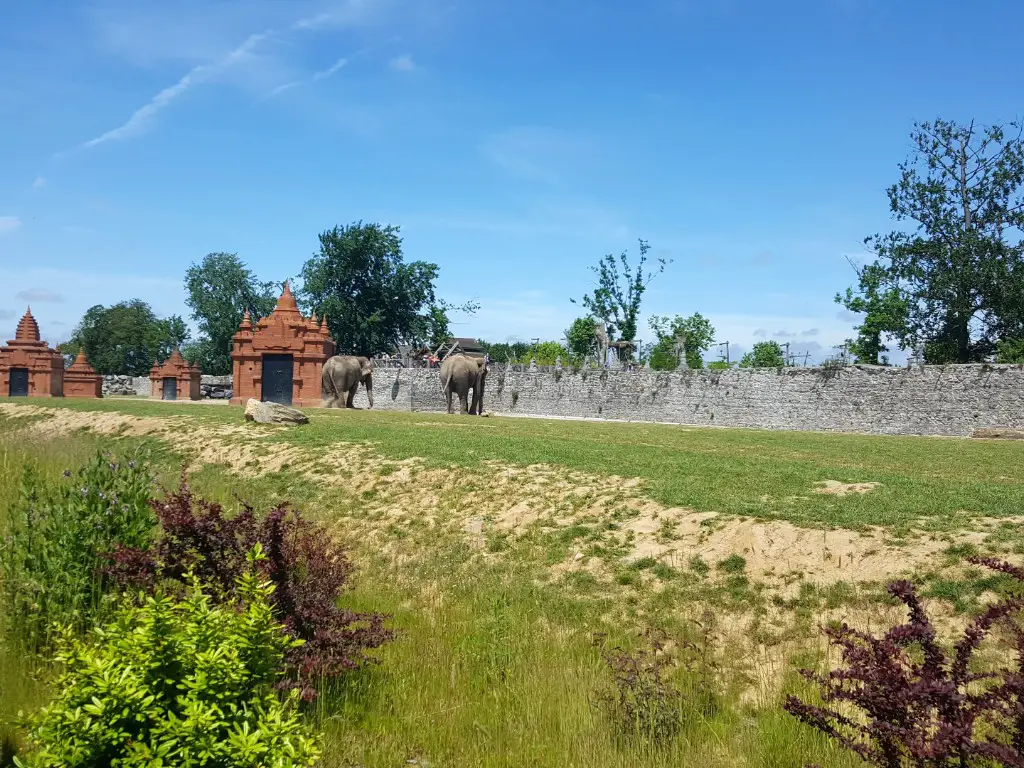
Pairi Daizi in Belgium was recently voted the best zoo in Europe and the most beautiful zoo in the Benelux! It goes without saying that a visit to Pairi Daiza is definitely a good idea!
This 65-hectare domain is the biggest zoo in Belgium and has no less than 7000 animals that you can pay a visit to. It’s also one of the largest zoos in Europe. Their most famous inhabitants are the giant pandas – it’s the first and only zoo in Belgium where you can see them and it’s one of the only zoos with pandas in Europe.
The entire domain is beautifully decorated and well-maintained, making it not only a nice trip to see animals but also a great place to walk around and enjoy the surroundings.
You can definitely spend an entire day at Pairi Daiza park. In fact, we spend an entire day (ok, I was pregnant and couldn’t walk that easily) and only managed to see about half!
One of the best things to do in the official Best European Zoo is to book a night at the park. The most special rooms offer an exclusive view over a certain group of animals. We’re a big fan of the full moon lodges. These little hobbit houses have a large window overlooking the play domain of the wolves and the bears. But you can also book a night with the polar bears or the tigers.
Contributed by Babs from Next Stop Belgium
The zoo is open from 10am to 6pm every day (except for a couple of weeks from mid January to mid February). You can find Pairi Daiza near the Cambron-Casteau train station on the Ath-Mons line! Tickets for 12 years old and above costs €37 and kids between 4 to 11 years old costs €32. Children under 3 years old get free access while visitors over 60 years old get a discounted rate of €35. You can also get a season pass that you can use for 11 months! For more details about their tickets and resort, visit Pairi Daiza’s website.
#4 Cotswold Wildlife Park and Gardens, UK
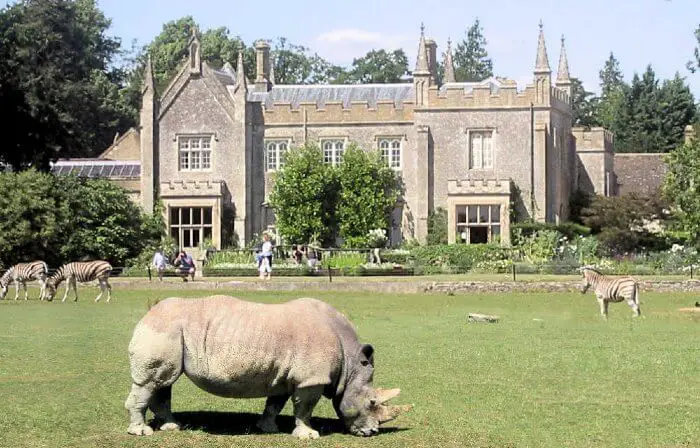
In the heart of the Cotswolds, in England, you’ll find Cotswold Wildlife Park and Gardens. A half-day visit provides a varied experience of a safari park drive and a walking tour. Most of the animals roam freely in large moated enclosures centered around a beautiful Gothic Style Manor House. The lack of fencing allows you to enjoy non-obtrusive observation.
Accented with pristine flower borders and manicured gardens, the Bradwell Grove Estate is reminiscent of nearby Sudeley Castle, without the animals. Animal species include the typical lions, giraffes, rhinos, and zebras. However, the park has more unusual small mammals such as wolverines, mongooses, lemurs, meerkats, and red pandas.
In recent years, the wildlife park has contributed to conserving some endangered species. Of its over 250 animal varieties, 40 of them are rare. Its Madagascar exhibit features some endangered lemur breeds. Some of these breeds are part of breeding programs to prevent declining numbers.
In 2013, the park formed the Cotswold Wildlife Park Conservation Trust. The charity aims to protect animals and their endangered terrains. Money raised from various sources helps fund their park’s endangered habitats and supports causes that preserve natural environments.
For over 50 years, park visitors have enjoyed one of the largest collections of reptiles in the United Kingdom. A park favorite, the giant tortoises greet guests on the lawns in front of the manor house.
Contributed by Karen from Forever Karen
The Cotswold Wildlife Park and Gardens open from 10am to 4 or 6 pm. Ticket prices start at £78.00 for adults while tickets for children 3 to 16 years old and seniors 65 and over only cost £55.00. If going with a family of 4 people, you can choose the family ticket for £250.00, which covers 2 adults and 2 children. For additional access for a child in the family ticket, you need to add £50.00 at the Costwold Wildlife Park and Gardens website.
#5 Copenhagen Zoo, Denmark

Copenhagen Zoo or Zoologisk Have Kobenhavn, is one of the oldest zoos in Europe and is one of the Denmark’s most visited attractions. With over 4000 animals, Copenhagen Zoo is a must-visit if you’re in the area.
The Zoo is really easy to get to; you can either take the M3 metro to Frederiksberg Alle and walk another 20 minutes to the Zoo or the 7A bus route to Zoologist Have (Roskildevej) which drops you right outside the gates. Both methods cost roughly 24 DK for a one-way ticket.
The zoo is divided into two parts and separated by the main road Roskildevej. The larger part of the zoo and the main entrance is to the north whilst the section is located to the south. Geniusly, the zoo has installed an underground passageway to allow easy access to both parks.


Easily one of the best animals to see are the two giant pandas currently on loan from China. Divided in separate enclosures, these amazing animals are fascinating to watch. However, seeing the Polar bears, kangaroos and sloths is also undoubtedly another highlight of the park!
Despite some recent controversy, Copenhagen Zoo is considered very ethical and the animals have ample space to roam. With 9 main exhibits spanning over 11 hectares, it is recommended to spend a full day exploring the different areas. The zoo has a couple of restaurants and multiple stands selling hot food and drinks to keep you going throughout your visit.
Contributed by Leah from Alex and Leah on Tour
The Copenhagen Zoo is open from 9am to 8pm with tickets costing only €26.20! You can also choose the Copenhagen City Pass to enjoy discounted and free passes to 89 attractions and transportation systems, including the Copenhagen Zoo.
#6 Edinburgh Zoo, Scotland

Famous for its giant pandas, the 82-acre Edinburgh Zoo is easily one of the best things to do in Edinburgh with kids with around 2,500 animals making their homes here, including rare and endangered species. It also has Europe’s largest outdoor penguin pool, and (when social distancing restrictions permit), the penguins themselves can waddle out for the daily parade, always a highlight for visitors.
You’ll find plenty of other family favourites, too, from lemurs and chimps to lions, tigers, koalas, and Malayan sun bears, plus a new giraffe habitat that opened in the summer of 2021. Along with daily keeper talks, there are often extra activities and events taking place too, such as the temporary dinosaur walk-through.
You’ll need at least half a day to explore, but you could fill a full day without any effort.
Buses run regularly from Edinburgh city centre to the zoo in the suburb of Corstorphine (plus limited parking and a family-friendly hotel right next door), which also has more space than many city zoos.
The animals’ welfare was key in its original design, while ethical practices have often been ahead of their time too. Elephant rides were an option for kids in its early days at the start of the 20th century, but the zoo stopped keeping elephants in captivity in 1988 and now has a sculpture helping to raise awareness and funds for elephant conservation, among other projects worldwide.
Contributed by Cathy from Mummy Travels
Prices for 1 adult Edinburgh Zoo ticket cost $24.48, while seniors and students with ID can access the zoo for only $22.21 per ticket. Tickets for children have a discounted price of $15.34. With the Edinburgh: 24-Hour or 48-Hour Hop-On Hop-Off City Tour, you get an unlimited pass to bus rides from Bright Bus Tours stop in St Andrew Square, additional discounts, and a bus ride to the Edinburgh Zoo!
# 7 Skansen Zoo Stockholm, Sweden
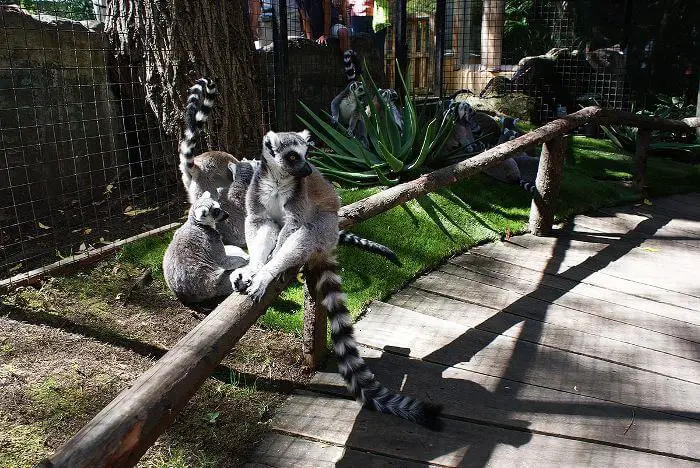
One of the most unique zoos to visit in Europe is Skansen Zoo in Stockholm. This open-air museum is not only a great place to see various animals but also to learn about Swedish history. From African species to domestic pets, this zoo is a perfect choice for a family day out in Stockholm.
Skansen Zoo is a huge site and it feels more like a town than a typical zoo. It is the oldest open-air museum in the world with interesting Nordic buildings and great views of Stockholm. On the site, you can visit Skansen Aquarium where you will see tropical fishes or lemurs that are running around the building freely.
It is a great place to see animals from close up and take amazing pictures with them. Just make sure to spend at least 2 hours in the zoo as there is much more to explore. From admiring Brown Bear, Otters, and Reindeer to enjoying a great meal in one of the zoo’s restaurants, visiting Skansen Zoo in Stockholm will be an unforgettable experience.
Contributed by Paulina from Ukeveryday
Pay only €20.57 for adult Skansen: Open-Air Museum and Nordic Zoo tickets for ages 16 and above! Seniors and students get discounted ticket prices of €18.70, while children ages 4 to 15 only need €6.55. If you want access to the Skansen Aquarium, the combo ticket only starts from €29.93.
#8 Beluga Whale Sanctuary, Iceland
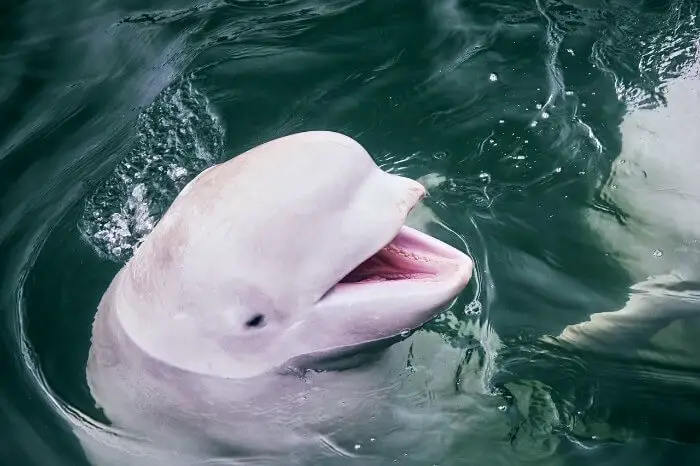
The Beluga Whale Sanctuary is located on the small island called Vestmannaeyjar which is part of the Westman Islands. The sanctuary is currently home to two beluga whales named Little White and Little Grey. Both whales have been held in captivity in a Chinese amusement park and dolphinarium located in Shanghai.
When Merlin Entertainments purchased the aquarium, they decided to create a new sanctuary in Iceland to give the animals more space in a natural environment. Together with the Whale and Dolphin Conservation (WDC), the Beluga Whale Sanctuary was born.
After traveling by plane for almost 6,000 miles, both Beluga whales are currently swimming in a sea pen sanctuary. In the visitors center you can visit a small museum about the project, an aquarium with native marine life, holding pens (here is where the beluga’s go if the weather is bad), and a few adorable puffins!
Did you know that puffins are a native bird species in Iceland? All the money that is raised from ticket sales is used to provide the best care possible for all the animals that are part of the sanctuary. The average spending time at the sanctuary is 2 hours. You can purchase a normal ticket for 2,100 ISK or combine your visit with a whale boat tour to the sea pen for 9,900 ISK. If you have some time left, trying one of the whale watching tours in Iceland is also an awesome idea and a great way to see the beautiful animals in their natural environment.
Contributed by Niels from Whale Watching Iceland
Sign up for a whale tour from Reyjavik, Akureyri, and Husavik! The Classic tour costs €77 to € 86 worth 3 hours, while the VIP tour lasting 2 hours starts from €122 to €150.
#9 Dublin Zoo, Ireland
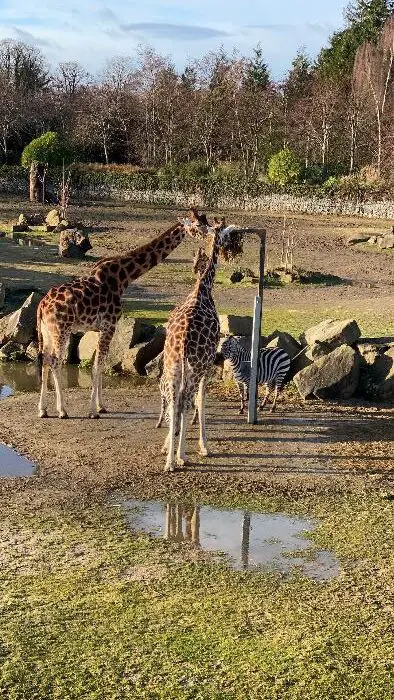
Dublin Zoo is a beautiful attraction in Ireland’s capital and one of the best things to do in Phoenix Park. It opened to the public in 1840 after the London zoo donated a number of animals. With 28 hectares, the grounds of Dublin Zoo attract over 1 million visitors every year, and for good reasons as it’s one of the top zoos in Europe.
The zoo is a lovely escape from the city and features some of the most stunning exotic animals in the world. The zoo is divided by regions of the world including the African Savanna, the Family Farm, and the Wolves in the Woods.
One of the zoo highlights is the Orangutans’ habitats. These beautiful animals are hosted on large grounds with lots of polls to climb. They can even climb and cross right above the visitor’s path for everyone’s pleasure! Another highlight is the elephant feeding time. It is not rare to see baby elephants at Dublin zoo so keep your eyes open!
The zoo is a registered charity and places a big emphasis on the conservation of biodiversity and the welfare of the animals. The zoo collaborates with other zoos and institutions to ensure their staff is best trained and animals are best taken care of. The animals have large enclosed spaces and there are no photo options with animals.
The visit takes about a short day and sometimes a full day if you want to take your time. As the zoo is located in Phoenix Park, you can prolong your experience with wild animals by checking out the wild deer in the park after leaving the zoo.
Contributed by Mary from Be Right Back
Regular tickets for adults online start at €18.25, while children under 3 years are free of entry. For children 3 to 15 years old, tickets cost €13.50, and senior tickets cost €13.95. You can visit the Dublin Zoo website for more ticket prices for families and groups.
#10 Karlsruhe Zoo, Germany
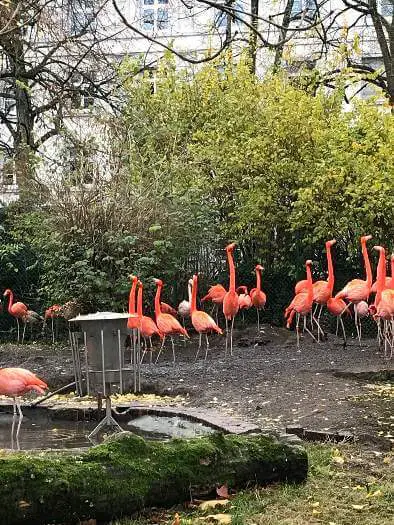
Karlsruhe zoological gardens is well worth a visit, being one of the oldest zoos in Germany, established in 1865. An Institution member of the World Association of Zoos and Aquariums (WAZA) it’s an organization dedicated to the care and conservation of animals and their habitats. The zoo is actively involved in local and global conservation projects for endangered species and the preservation of habitats.
It’s located within easy walking distance of the city center, just north of the central railway station. The zoo is incorporated within the municipal gardens, offering many themed garden sections complementary to an extensive selection of animal enclosures. A map of the zoo allows for easy navigation.
The zoo is home to some 250 species presented in themed sections mimicking the habitats of each species. The Water Habitat showcases penguins, seals, and sea lions, with polar bears next door in the Tundra Habitat.

Three large African savanna enclosures exhibit both large and small representative species from Africa’s animal kingdom. The Himalayan Mountains exhibit was established to house the Snow Leopards, with the zoo being part of Europe’s Snow Leopard breeding program.
When planning your visit to the zoo, allow at least half a day to enjoy the gardens and the zoo. Enjoy a unique perspective of the zoo in one of the gondoletta, connecting the north and south water areas with a canal (40min return). Enjoy the gardens with a picnic lunch or dine at the café or waffle kiosk on site.
Contributed by Jeanine from Let’s go a Wandering
Karlsruhe Zoo day tickets cost €13.00, while children ages 6 to 15 get a discounted price of €5.50. The zoo’s annual tickets are affordable too, costing only €48.00 for adults and €22.00 for children. Visit their website for more information about their day and annual ticket prices.
#11 Berlin Zoo, Germany
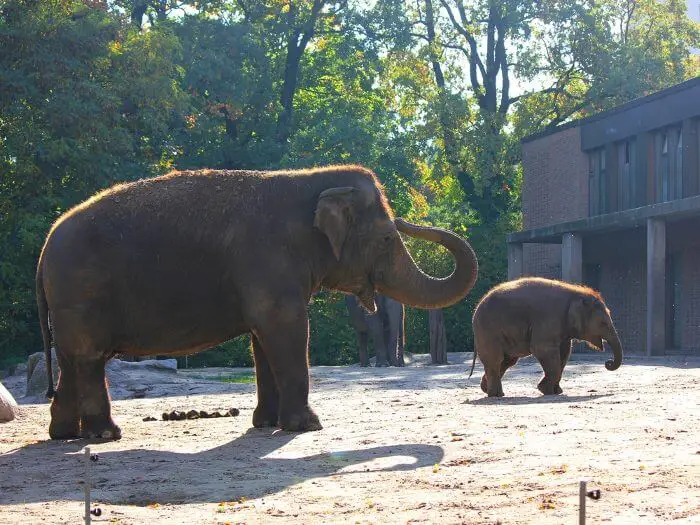
Berlin actually has two zoos – one in the west and one in the east – but the Berlin Zoological Garden in the western side of the city is one of the most popular zoos in Europe. It’s also the oldest zoo in Germany. The Eastern zoo, Tierpark Zoo is the biggest zoo in Europe.
With more than 20,000 animals from over 1,000 species, the Berlin Zoo has the biggest variety of species of any zoo in the world. This is definitely an impressive place to visit if you’re interested in animals. The Berlin Zoo is also home to Germany’s only giant pandas.
Aside from pandas, you can also see elephants, zebras, giraffes, penguins, flamingos, kiwis, tigers, and many other animals from around the world, including local species. The Berlin also has an aquarium where you can see all kinds of fish and other sea creatures, reptiles, amphibians, and insects.
The animals come first at the Berlin Zoo, and conservation is very important here. The zoo works to protect endangered species and reintroduce certain animals back into their normal habitat. For example, European bison and bearded vultures have been successfully released into the wild in several places. They’re also trying to protect and reintroduce the Vietnamese pheasant into its natural habitat where it is believed to be extinct.
The Berlin Zoological Garden should definitely be on your Berlin bucket list, especially if you’re traveling with kids. Plan on spending at least a couple of hours wandering around to see the different animals, and check feeding schedules ahead of time. The zoo has a detailed map so you can plan your route to different sections, such as the elephant area, primate area, penguin area, etc.
The closest transport station is the Zoo station, which can be reached on the U1, U9, and several Sbahn lines and regional train lines.
Contributed by Ali from Berlin Travel Tips
Dublin Zoo tickets cost €17 for adults, while children ages 4 to 15 cost €8,50. Children under 4 years old get free access. Dublin Zoo is open from 9am to 6:30pm.
#12 Bioparc, Valencia
Bioparc is one of the most impressive zoos in the world and can definitely count as one of Europe’s best zoos. As one of the best things to do in Valencia, Spain, this zoo is all about being respectful towards the animals. Bioparc is built around the concept of zoo immersion, and while visiting it, you’ll feel more like you’re visiting a safari than a traditional zoo.
While you are perfectly safe walking the alleys, the animals have plenty of space to roam around as well. There are no cages and no fences, instead, all borders between habitats are natural, like streams of water. The park is divided into four habits — Madagascar, Ecuatorial forest, Savanna, and the wetlands.
The cutest inhabitants and everyone’s favorite are the lemurs. But it’s quite possible the elephants, giraffes and the gorillas will steal your heart as well. With over 100.000 sqm and more than 800 animals to see, you can visit Bioparc in a minimum of two hours. But you might be quite tempted to spend the whole day.
Contributed by Laura from Travelers Universe
The Bioparc is open from 10 am to 8pm, and adults ages 13 to 64 can enter the park at €26.90. Tickets for seniors get a discounted price of €20.60 while children 4 to 12 years old can get their tickets for €21.00. You can also get affordable Bioparc tickets for groups and families.
#13 Lagos Zoo, Portugal
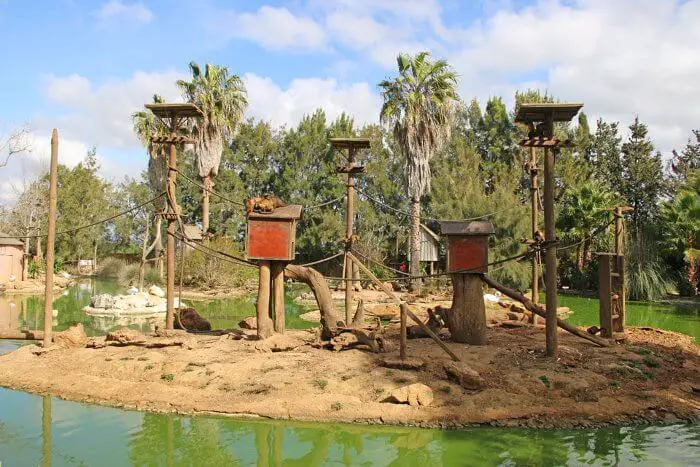
Lagos Zoo is situated in a quiet area 8 km outside of the town of Lagos, one of the most popular beach towns in the Algarve region of Portugal.
Over 140 animal and bird species from 5 continents can be found in Lagos Zoo. The zoo is divided into different zones each representing a region e.g. Australia, Africa, tropics, etc. Mammals and most birds are kept in open-plan enclosures surrounded by trees that provide shade and create a natural environment. Enclosures have enough space for animals to roam around. No photos with animals are available.
During the summer season from 1st April to 30th September, there is a sandy beach and a kids pool at the zoo near the rocky pool with African penguins. A visit to the zoo is one of the not-to-miss things to do in Lagos for travellers with children. One needs 2-3 hours to visit the zoo. There is a restaurant, a picnic area, a playground, and a souvenir shop inside the zoo. It’s open daily from 10 am to 7 pm (5 pm in winter).
Lagos Zoo is a member of the EAZA (European Association of Zoos and Aquariums). It takes part in several conservation projects among them Hornbill Conservation Project in Thailand and India, Primate Rehabilitation Centre in Congo, and the Cotton Top Tamarin Conservation Club in Colombia.
Contributed by Alya from Algarve Family
Lagos Zoo takes you on an outdoor zoo adventure with adult tickets costing €16.00, available for visitors ages 12 to 64. Children 4 to 11 years old and seniors ages 65 and above can enter with tickets costing €12.00 and €14.00, respectively.
#14 Fota Wildlife Park, Ireland

Fota Wildlife Park in Cork is one of Ireland’s most popular tourist destinations, and it is easy to see why.
The park is home to over 140 native and exotic animals, including red pandas, lions, and giraffes.
You’ll start out with the Cheetahs directly outside the main entrance and continue through the Asian Sanctuary to the Tiger Forest followed by the adorable Red Pandas.
You’ll then come to the lake where you can buy food for the ducks. After this, it’s monkeys, gibbons, kangaroos, and more. Plus a good playground and an ice cream kiosk (of course!).
Animal welfare is a top priority at Fota Wildlife Park, and the staff works hard to ensure that all of the animals are healthy and happy.
The animals at Fota Wildlife Park are well-cared for and have ample space to roam – spread across 100 acres. There are opportunities throughout the warmer months to see the animals being fed – with feeding times a day on offer.
Fota is best enjoyed on a dry day as you will be spending most of your time outside (be sure to wear good walking shoes).
Current restrictions mean a one-way system is in place through the park. It’s well-signposted and easy to follow.
The cafes on site are reasonably priced and the coffee is surprisingly good.
If you drive, you’ll need to pay a €3 parking charge. This entitles you to access Fota House and Gardens which are adjacent to the wildlife park and worth exploring if the sun is out.
Allow up to 3 hours to enjoy the park, although you could squeeze it into 2 hours if you were really pushed.
Contributed by Emma from Our Spanish Life
FOTA Wildlife Park entry tickets cost €17.20 for adults, while children under 16 years old only need to pay €11.90. Students and seniors get a discounted ticket price of €12.90. Toddlers up to 36 months are free of entry. They also have affordable ticket prices ranging from €52.00 to €69.00.
#15 Wroclaw Zoo, Poland
Wroclaw Zoo is the oldest (and largest) zoo in Poland, and it hosts more than 10,000 animals. It’s located in the central part of the city, right in front of Centennial Hall. There’s a large parking lot available near the Hall, if you arrive by car. One thing to
keep in mind: Wroclaw Zoo gets very crowded on the weekends, with long entrance queues, so be prepared to spend the whole day here.
Inside, you’ll find 1,132 animal species, including monkeys, giraffes, rhinos, kangaroos, wolves, flamingos, and many more. The zoo is conveniently divided into sections: the Africarium (which includes the fauna of Africa, and a breathtaking underwater tunnel), the aquarium, the terrarium, and a few pavilions (with monkeys, birds, elephants, and other animals). It’s recommended to check the map in advance and make a plan of what you’d like to see because once you’re inside, time flies very fast.
Wroclaw Zoo’s visiting terms allow taking photos of the animals, but without a flash.
Animals here are kept in good conditions, very close to their natural habitats. Aside from being fun, the Wroclaw Zoo teaches people about animals and has a successful breeding program that helps protect species that are in danger of going extinct.
Wroclaw Zoo is open all year round, including holidays: Mon-Thu: 9:00 – 18:00; Fri-Sun, and holidays: 9:00-19:00; You can buy the tickets online (the recommended option) or at the cash desk (the queues are usually very long). A regular ticket costs 60 PLN.
Contributed by Leslie from Backpackers Thailand
Regular tickets to the Wroclaw Zoo costs 60 zl while students only need to pay 50 zl. You can also avail of group and family tickets at their website. If you want private transportation to and from the zoo, choose the Wroclaw: Zoo with Private Transport and Tickets for only $70.28.
The Best Safari Parks in Europe
#1 Serengeti Park, Germany
Besides the Karlsruhe Zoo, you may also want to go on a wildlife tour at Germany’s Serengeti Park!
Located in Hodenhagen, the whole family can get up close with tigers, bison, zebras, and more animals found in Africa. With over 200 hectares of land, the Serengeti Park in Germany is still considered the biggest safari park in Europe!
You can use your own vehicle to ride through the park or join other tourists and families on the safari bus! Serengeti Park also has many attractions, such as the Jungle Safari to meet 200 species of monkeys and the Petting Safari to cuddle and help feed donkeys, goats, and even alpacas.
The safari park also holds the best facilities to breed white rhinos, elephants, and other species of animals! The fun does not end with meeting and exploring animals. The whole family can spend the rest of the day riding a roller coaster, trying the rope course, and experiencing more than 40 rides and shows!
Serengeti Park lets you park your car for free, and adult tickets cost €34.50. People with disabilities and their accompanying person gets discounted tickets for only €17.00 per person. If you are coming with the whole family, children’s tickets cost €27.50. You can walk or ride the Serengeti bus for only €5.50 per person.
#2 Beekse Bergen, The Netherlands
When you reach the Netherlands, be sure to include Beekse Bergen in your itinerary too!
It is the largest animal park in the country, so it may take more than a day for the whole family to experience all the attractions. You can either walk or drive your own car to tour the wild park.
To get the complete tourist experience, you can ride Beekse Bergen’s safari bus along with other travelers! The boat safari also offers a unique view of the safari tour. Both amenities let you in on facts about the animals you will see along the trail.
One attraction you should include in your trip to the safari park is the Birds of Prey Safari. The whole family can sit back and discover survival instincts and other characteristics of these useful species of birds.
Another sight to see is the animals feeding time. Rangers will tell you about chimpanzees, elephants, and other animals’ eating habits and favorite food. Plus, you also get to be close to them as rangers feed them just along the safari trail!
The safari park day ticket starts from €27 for guests 10 years old and up, while tickets for children 3 to 9 only cost €21,50. Children under 3 years old get a free pass to the safari park.
FAQ
What is Europe’s biggest zoo?
Port Lympne Wild Animal Park is currently the largest zoo in Europe, with over 600 acres of land, located at Hyte, Kent, England! The animal reserve houses the Port Lympne Mansion from World War I and 90 species of animals, some of them are rare and endangered.
How Many Zoos Are In Europe?
As of 2022, the European Association of Zoos and Aquaria recorded 149 accredited zoos all over Europe!
What is the Busiest Zoo in Europe?
Zoologischer Garten of Berlin is the most-visited zoo in Europe today, with over 3 million visitors annually. On its more than 80 acres of land, the zoo houses more than 20,000 animals of 1,500 species. It is also the zoo that has the most animals and animal species.
What Is The Oldest Zoo In Europe?
Tiergarten Schönbrunn, or Vienna Zoo, is the oldest zoo in the world, which opened in 1752! As the best scientifically-managed zoo, it is currently the model for animal conservation. The zoo still offers everyday animal attractions and education tours for bother day and night!
What Country Has The Most Zoos?
According to the Association of Zoos and Aquariums, the United States of America has the most number of accredited zoos with 215 across 46 states!
Wrapping up the best zoos in Europe
So, what do you think? Have you visited any of these popular zoos in Europe? Let us know your experiences! We would also love to hear your thoughts and recommendations for this list of zoos in Europe.
Mums on Flipflops is a participant in the Amazon Services LLC Associates Program, an affiliate advertising program designed to provide a means for sites to earn advertising fees by advertising and linking to amazon.com, amazon.co.uk, amazon.ca, amazon.de, amazon.fr, amazon.it and amazon.es. Amazon and the Amazon logo are trademarks of Amazon.com, Inc. or its affiliates.

ABOUT THE AUTHOR
Babs Rodrigus is the co-founder and main writer of Mums on FlipFlops . She is absolutely crazy about traveling – especially together with her wife and kids. Babs loves animals, chocolate (what did you expect from a Belgian?), reading, and writing.

ABOUT THE AUTHOR
Babs Rodrigus is the co-founder and main writer of Mums on FlipFlops . She is absolutely crazy about traveling – especially together with her wife and kids. Babs loves animals, chocolate (what did you expect from a Belgian?), reading, and writing.

